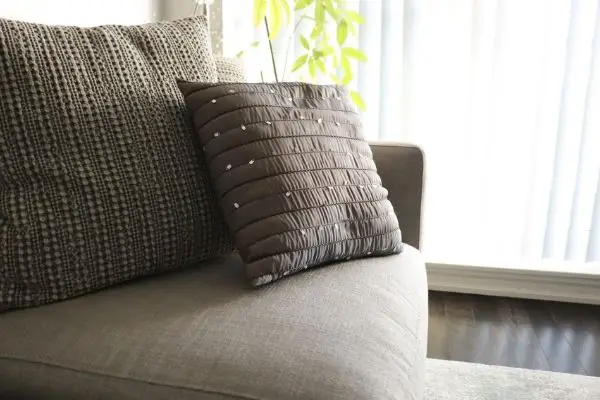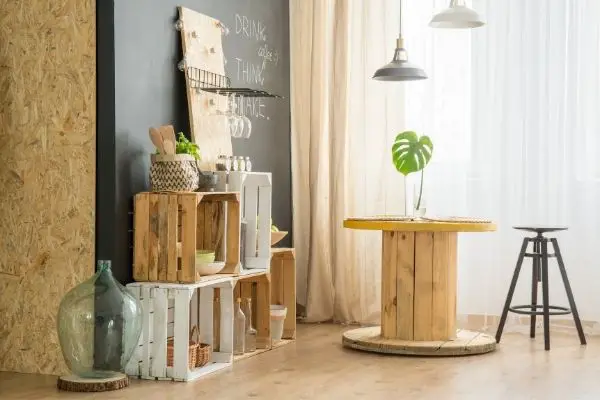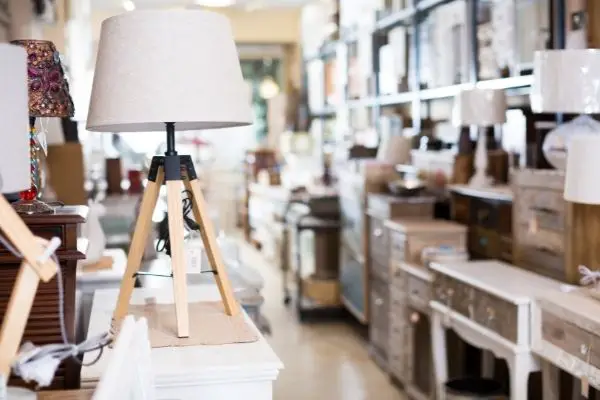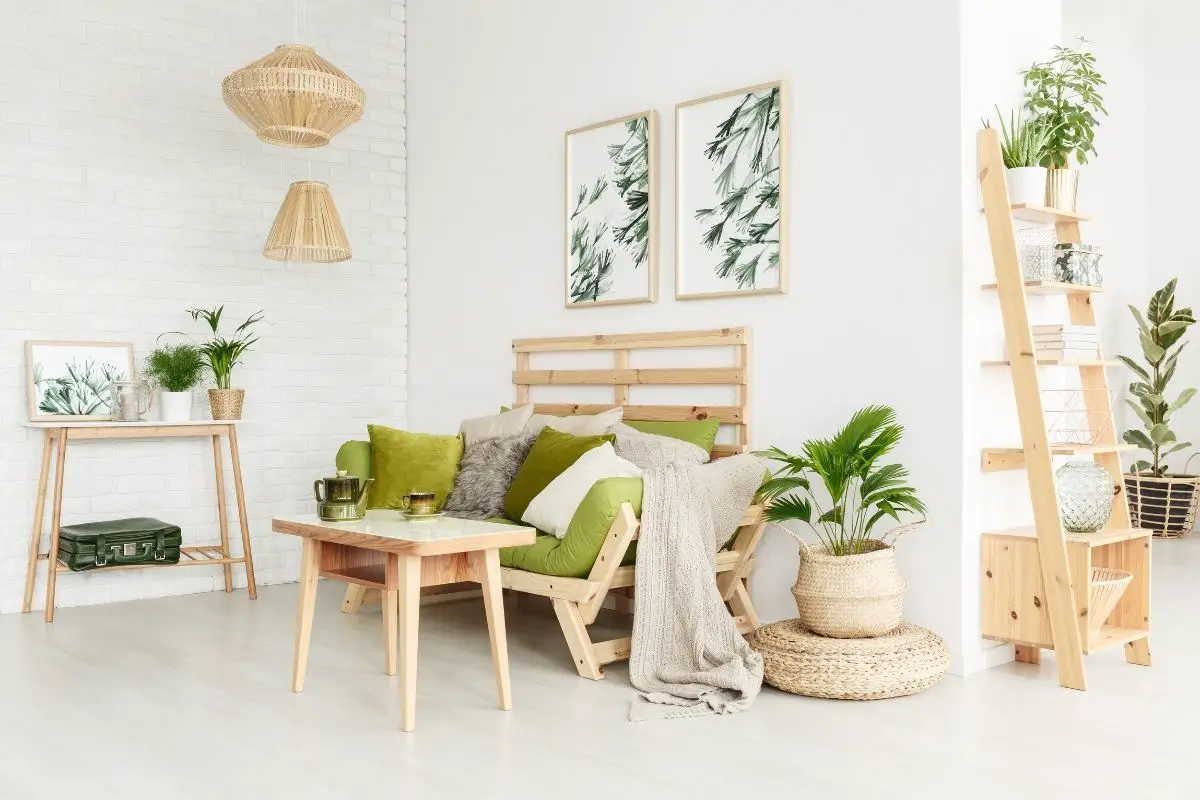Home Decor Ideas: Eco-Friendly Materials for Furniture
Adhering to an eco-friendly lifestyle is never-ending!
It’s easy to focus our energy on day-to-day items like laundry detergent or toilet paper. But big household purchases — like new furniture — are just as important.
Furniture manufactured with sustainable materials should be a no-brainer. The question is which materials are good for the environment and which are best kept out of the home.
Bamboo, hardwood, hemp, and wool are all environmentally friendly and biodegradable options. Even plastic can be recycled to create eco-friendly furniture while minimizing landfill waste.
5 Environmentally Friendly Materials for Furniture
1. Bamboo

One of the first materials that come to mind when you think of eco-friendly furniture is probably bamboo!
The reason bamboo is so popular in the world of sustainability is because it grows remarkably fast. Bamboo can grow up to 3 feet per day. Meanwhile, hardwood trees can take more than a year to grow 3 feet.
Bamboo can be used in much the same way as wood. Manufacturers can create sustainable bamboo furniture or weave stalks of bamboo into a rattan-style material.
Pros
- Extremely durable
- Mimics the look of real wood
- May be used indoors or outdoors
- Lighter than hardwood
Cons
- Almost all bamboo is shipped from Asia
- Not all bamboo farms utilize sustainable practices
- May contribute to deforestation
- Scratches easily
- Sensitive to humidity
2. Wood

Many furniture shoppers are quick to assume that wood furniture is unsustainable. In many cases, though, wood is one of the most environmentally friendly materials out there!
It’s crucial to select wood furniture that has been responsibly harvested and manufactured. Not all furniture is created equal — both in terms of quality and sustainability.
Also, low-quality wood furniture should be avoided. Instead, invest in solid wood furniture that will last for years (lowering the number of trees that must be harvested to make furniture in the future).
Pros
- Can often be locally sourced
- Many different species of wood are available
- Lasts for many years
- Can easily be refinished or repainted
- Can be used indoors and outdoors
Cons
- High-quality hardwood can be expensive
- May contribute to deforestation
- Some wood species are endangered
3. Hemp

One factor many eco-conscious furniture shoppers overlook is the upholstery. Upholstery plays a large role in whether a piece of furniture is sustainable or not.
Hemp is a wonderful alternative to many popular natural and synthetic fibers used in upholstery. It can also be blended with other materials, like cotton, to create a more sustainable hybrid fabric with the benefits of both fibers.
Hemp is famous for its sheer strength, and this trait transfers to any upholster made from fiber. Hemp furniture is remarkably durable (even puncture-resistant!).
Pros
- Requires fewer resources than other natural fibers
- Holds its shape up to 3 times better than cotton
- Very puncture-resistant
- Resistant to moisture and mildew
- Softens with age
Cons
- Not yet widely available
- Not as soft as 100% cotton
- Not colorfast (dyed hemp is not very vibrant)
4. Wool

Ethically sourced wool is incredibly good for the environment. Although Merino wool is one of the most popular varieties used in upholstery, you can also use specialty fibers sourced from alpaca and other animals.
Natural wool can be dyed in nearly any color. It can also be woven into a wide variety of unique patterns to suit your home decor style.
Upholstery made from wool is naturally dust- and static-resistant. Wool fibers hold their shape extremely well, so sofas, chairs, and other items made with this material will stand up to years of wear and tear.
Pros
- Extremely durable
- 100% biodegradable
- Available in many patterns and colors
- Naturally resistant to dirt
Cons
- Not all wool is ethically sourced
- Not considered vegan
- Dry-clean only
- More expensive than other upholstery materials
5. Recycled Goods

It should come as no surprise that the most sustainable materials for furniture are recycled!
Recycled furniture comes in many different forms. Many people DIY their own eco-friendly furniture using reclaimed wood and other materials. Some designers specialize in sourcing recycled fabric to turn it into unique upholstery.
Post-consumer plastic can be used to create sustainable furniture as well.
Remember: Anything that keeps would-be waste out of landfills is an eco-friendly solution!
Pros
- Prevents items from ending up in landfills
- Often more affordable than “new” materials
- Many different materials can be used
Cons
- May be difficult to find
- Limited design options
- May be less durable than other sustainable furniture materials
Are There Other Options For Sustainable Furniture?
These eco-friendly furniture materials are a great way to limit your environmental impact when shopping for new home items. But the most sustainable furniture can’t be bought new.
Pre-owned furniture is — without a doubt — the best way to create an eco-conscious living space. Opting for used items whenever possible can also help save money.
This practice keeps usable furniture out of landfills while lowering the demand for new furniture (and the materials harvested to create it).

However, not all secondhand furniture is the same. It’s important to understand how much time and energy you’re able to put into restoring items that may be damaged or cosmetically worn.
Fortunately, there’s a near-constant stream of gently used furniture leaving households at any given time. You may be surprised by how many like-new items you’re able to get your hands on!
Frequently Asked Questions
What is the most eco-friendly material for outdoor furniture?
Reclaimed wood is one of the best materials for sustainable outdoor furniture. Bamboo can also be used outdoors but must be sealed against moisture.
Outdoor-safe fabric for cushions can be made from hemp. Ready-made patio cushions can be hard to come by. You may need to purchase raw yardage and sew outdoor cushions yourself (or hire a professional to make custom pillows for you).
Is IKEA furniture sustainable?
IKEA furniture definitely isn’t the most sustainable option out there. But you don’t need to give up shopping from the brand altogether.
Recently, IKEA has released plans to source more materials from sustainable and ethical sources. In 2018, the company pledged to use only renewable and recycled materials by 2030.
The most unsustainable aspect of IKEA’s brand is its focus on cheap, disposable items. As a consumer, you can avoid contributing to this problem by only purchasing furniture you plan to use for several years.






